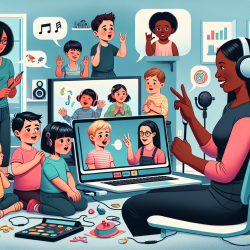The field of speech-language pathology (SLP) is continually evolving, and recent research has highlighted the potential of remote assessments to enhance accessibility and effectiveness. A pivotal study titled "Taking Language Samples Home: Feasibility, Reliability, and Validity of Child Language Samples Conducted Remotely With Video Chat Versus In-Person" sheds light on the viability of remote language sampling. This blog post will delve into the key findings of this research and provide practical insights for practitioners looking to improve their skills or explore further research in this domain.
Key Findings from the Research
The study conducted by Manning et al. (2020) compared child language samples collected in-person with those collected via video chat. The results indicated no significant differences in key speech and language measures between the two methods. Here are the main takeaways:
- Feasibility: Of the 166 video chat samples collected, 98.8% had sufficient audio quality for transcription and analysis.
- Validity: Key speech and language metrics, including mean length of utterance (MLU), number of different words (NDW), and type-token ratio (TTR), showed no significant differences between in-person and video chat samples.
- Reliability: Transcription reliability was high for both in-person and video chat samples, with no significant differences observed.
Implications for Practitioners
These findings suggest that remote language sampling can be a reliable and valid method for assessing children's language development. Practitioners can consider incorporating video chat assessments into their practice, especially when in-person assessments are not feasible. Here are some best practices and lessons learned from the study:
Planning for the Session
- Communicate with parents in advance to set expectations and provide relevant information.
- Ensure the session takes place in a quiet, indoor environment with minimal distractions.
- Recommend appropriate toys and discourage the use of noisy or electronic toys.
Addressing Parent Concerns
- Reassure parents that the child will not be directly interacting with the screen.
- Encourage the use of a mobile device that can be moved around with the child.
Technology Considerations
- Ensure video chat software complies with relevant IRB and/or HIPAA regulations.
- Recommend the use of ethernet or Wi-Fi rather than cellular signals to improve connection quality.
- Advise parents to place mobile devices in a horizontal orientation for a wider field of view and better sound quality.
Encouraging Further Research
While this study provides robust evidence supporting the feasibility and validity of remote language sampling, there are areas that warrant further investigation. Future research could explore:
- The effectiveness of remote assessments for older children and different sampling contexts.
- The impact of various home environments and technology types on assessment outcomes.
- Detailed analysis of phonological or articulation errors using remote methods.
To read the original research paper, please follow this link: Taking Language Samples Home: Feasibility, Reliability, and Validity of Child Language Samples Conducted Remotely With Video Chat Versus In-Person.










